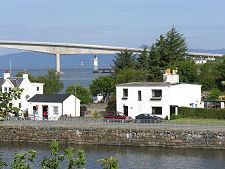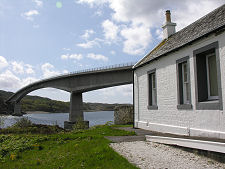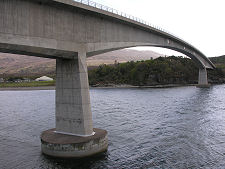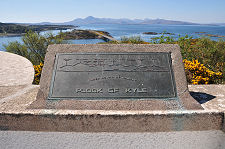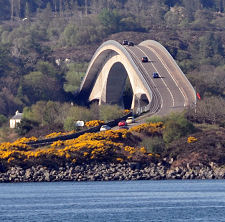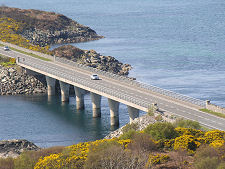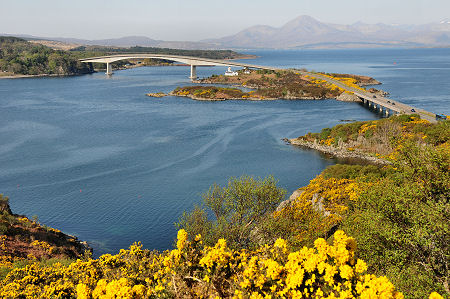 The Skye Bridge Seen from the Am Ploc Viewpoint |
There's something romantic about an island, and for many people the most romantic of Scottish islands is Skye. Since 16 October 1995, Skye has been linked to mainland Scotland by a bridge, and there are those who feel it ceased to be a true island as a result. For others, the Skye Bridge is simply a faster and more reliable way to cross to the Isle of Skye. As the image above shows, it is actually two bridges, which use the island of Eilean Bàn as a stepping stone en route.
Until 1995 you had a choice of three ferry routes to Skye. The CalMac ferry from Mallaig to Armadale remains a firm favourite, while the Glenelg to Kylerhea ferry continues to provide a March to October alternative for those wishing to explore a fascinating corner of the Highlands. But in October 1995 the ferries from Kyle of Lochalsh to Kyleakin were withdrawn from service, and traffic instead began to use the new Skye Bridge.
Kyle of Lochalsh had been the location of a ferry link to Skye since 1600 or earlier, though cattle en route to lowland markets still had to swim across the half kilometer of water as late as 1800, often breaking the swim on the island of Eilean Bàn. You can read an account of the difficulties of using the ferry in 1864 in our eBooks version of "A Summer in Skye" by Alexander Smith. The coming of better road links to Kyle in 1819, and the completion of the railway from Inverness in 1897, confirmed Kyle of Lochalsh in its role as the primary link to Skye: with Kyleakin as its counterpart on the island. (Continues below images...)
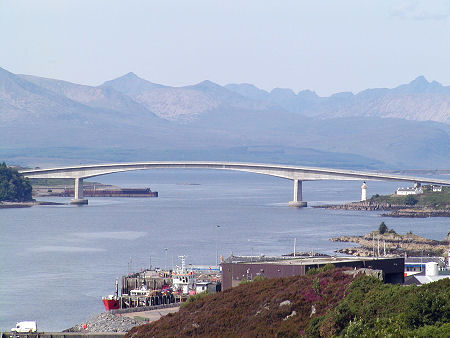 Skye Bridge Framed by the Cuillin, & Kyle of Lochalsh in the Foreground |
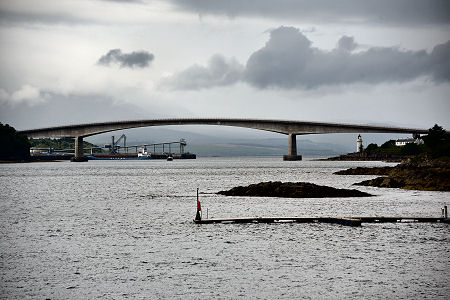 A More Recent Photograph Showing the Intrusion Into the View of the Fish Food Plant |
Some will still remember Kyle of Lochalsh and Kyleakin as places in which you unwillingly queued for the ferries at busy times. This all changed with the opening of the bridge. The road from the Skye end of the bridge bypasses Kyleakin, making it a rather quieter place than it used to be, while Kyle of Lochalsh is, if anything, still more bustling than before and much more attractive.
The Skye Bridge was the subject of controversy both before it was built and during its construction: and it remained controversial afterwards. The tolls set when the bridge opened were based on the fares of the ferries it replaced, and as a result it became, taking length into account, the most expensive toll bridge in Europe. Often overlooked in the heat of the debate were the benefits the bridge offered over the ferries it replaced. It is open 24 hours per day; it isn't nearly so subject to adverse weather; the ferry queues that blighted the area in Summer disappeared overnight; and when tolls were charged, regular users of the bridge paid only about half price anyway. Most importantly, the bridge was only built at all because of a funding package that assumed the tolls would mirror the ferry fares.
On the other hand, once the bridge was built it was logically very difficult to justify tolls on the Skye Bridge when a number of other bridges built to replace ferries in the Highlands were toll free: examples being the Kessock, Kylesku and Ballachulish bridges. In the end, and almost in spite of some of the more fanciful economic arguments put forward by some opponents of the tolls, the Scottish Government grasped the nettle, and at 7.30am on 21 December 2004 tolls were removed from the bridge. There has since been no charge for crossing the Skye Bridge in either direction, and the bridge is no less beautiful for being free. Though the arrival of a fish food plant in the old Kyleakin quarry has intruded significantly into views of the bridge from Kyle of Lochalsh.
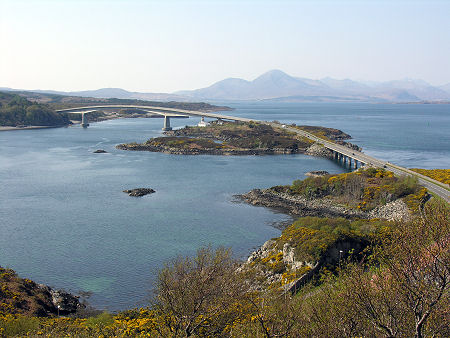 Another View from the Am Ploc Viewpoint |

|
|
|
Visitor InformationView Location on MapCrossing the bridge is free. What3Words Location: ///robot.houseboat.flow |
The Skye Ferry In Fiction
|
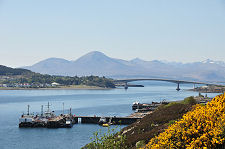 The Bridge, and Kyle of Lochalsh |
 Seen from Below |
 Island and Bridge |
 Passing Under the Bridge at Dawn |
 The Bridge Under Construction |
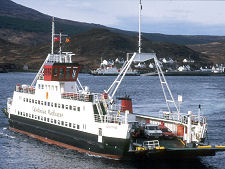 Loch Fyne: One of the Ferries Replaced by the Bridge |
 The Eye of Horus by Ken Lussey (18 June 2024).
The Eye of Horus by Ken Lussey (18 June 2024).
